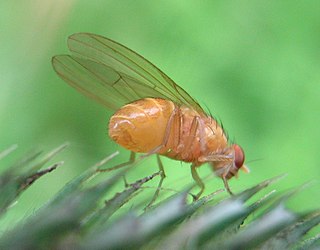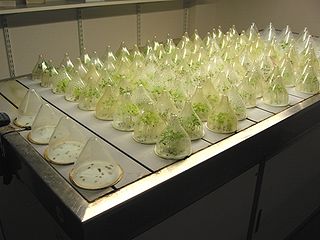Related Research Articles

Biology – The natural science that studies life. Areas of focus include structure, function, growth, origin, evolution, distribution, and taxonomy.
Zoology is the branch of biology that studies the animal kingdom, including the structure, embryology, evolution, classification, habits, and distribution of all animals, both living and extinct, and how they interact with their ecosystems. The term is derived from Ancient Greek ζῷον, zōion ('animal'), and λόγος, logos.

Salmonidae is a family of ray-finned fish that constitutes the only currently extant family in the order Salmoniformes. It includes salmon, trout, chars, freshwater whitefishes, graylings, taimens and lenoks, which are collectively known as the salmonids. The Atlantic salmon, whose Latin name became that of its genus Salmo, also derives the family and order names.

Max Ludwig Henning Delbrück was a German–American biophysicist who participated in launching the molecular biology research program in the late 1930s. He stimulated physical scientists' interest into biology, especially as to basic research to physically explain genes, mysterious at the time. Formed in 1945 and led by Delbrück along with Salvador Luria and Alfred Hershey, the Phage Group made substantial headway unraveling important aspects of genetics. The three shared the 1969 Nobel Prize in Physiology or Medicine "for their discoveries concerning the replication mechanism and the genetic structure of viruses". He was the first physicist to predict what is now called Delbrück scattering.

The National Institute of General Medical Sciences (NIGMS) supports basic research that increases understanding of biological processes and lays the foundation for advances in disease diagnosis, treatment, and prevention. NIGMS-funded scientists investigate how living systems work at a range of levels, from molecules and cells to tissues and organs, in research organisms, humans, and populations. Additionally, to ensure the vitality and continued productivity of the research enterprise, NIGMS provides leadership in training the next generation of scientists, in enhancing the diversity of the scientific workforce, and in developing research capacity throughout the country.
Pathophysiology – a convergence of pathology with physiology – is the study of the disordered physiological processes that cause, result from, or are otherwise associated with a disease or injury. Pathology is the medical discipline that describes conditions typically observed during a disease state, whereas physiology is the biological discipline that describes processes or mechanisms operating within an organism. Pathology describes the abnormal or undesired condition, whereas pathophysiology seeks to explain the functional changes that are occurring within an individual due to a disease or pathologic state.

Evolutionary anthropology, the interdisciplinary study of the evolution of human physiology and human behaviour and of the relation between hominids and non-hominid primates, builds on natural science and on social science. Various fields and disciplines of evolutionary anthropology include:

Plant physiology is a subdiscipline of botany concerned with the functioning, or physiology, of plants. Closely related fields include plant morphology, plant ecology, phytochemistry, cell biology, genetics, biophysics and molecular biology.

The rainbow trout is a trout and species of salmonid native to cold-water tributaries of the Pacific Ocean in Asia and North America. The steelhead is an anadromous (sea-run) form of the coastal rainbow trout(O. m. irideus) or Columbia River redband trout (O. m. gairdneri) that usually returns to fresh water to spawn after living two to three years in the ocean. Freshwater forms that have been introduced into the Great Lakes and migrate into tributaries to spawn are also called steelhead.

Hyperplasia, or hypergenesis, is an enlargement of an organ or tissue caused by an increase in the amount of organic tissue that results from cell proliferation. It may lead to the gross enlargement of an organ, and the term is sometimes confused with benign neoplasia or benign tumor.

Conservation genetics is an interdisciplinary subfield of population genetics that aims to understand the dynamics of genes in populations principally to avoid extinction. Therefore, it applies genetic methods to the conservation and restoration of biodiversity. Researchers involved in conservation genetics come from a variety of fields including population genetics, molecular ecology, biology, evolutionary biology, and systematics. Genetic diversity is one of the three fundamental levels of biodiversity, so it is directly important in conservation. Genetic variability influences both the health and long-term survival of populations because decreased genetic diversity has been associated with reduced fitness, such as high juvenile mortality, diminished population growth, reduced immunity, and ultimately, higher extinction risk.

Oncorhynchus is a genus of fish in the family Salmonidae; it contains the Pacific salmon and Pacific trout. The name of the genus is derived from the Greek ὄγκος + ῥύγχος, in reference to the hooked snout that the males develop during mating season.

Phenotypic plasticity refers to some of the changes in an organism's behavior, morphology and physiology in response to a unique environment. Fundamental to the way in which organisms cope with environmental variation, phenotypic plasticity encompasses all types of environmentally induced changes that may or may not be permanent throughout an individual's lifespan. The term was originally used to describe developmental effects on morphological characters, but is now more broadly used to describe all phenotypic responses to environmental change, such as acclimation (acclimatization), as well as learning. The special case when differences in environment induce discrete phenotypes is termed polyphenism.
In the study of the biological sciences, biocommunication is any specific type of communication within (intraspecific) or between (interspecific) species of plants, animals, fungi, protozoa and microorganisms. Communication basically means sign-mediated interactions following three levels of rules. Signs in most cases are chemical molecules (semiochemicals), but also tactile, or as in animals also visual and auditive. Biocommunication of animals may include vocalizations, or pheromone production, chemical signals between plants and animals, and chemically mediated communication between plants and within plants.

Evolutionary physiology is the study of the biological evolution of physiological structures and processes; that is, the manner in which the functional characteristics of individuals in a population of organisms have responded to natural selection across multiple generations during the history of the population. It is a sub-discipline of both physiology and evolutionary biology. Practitioners in the field come from a variety of backgrounds, including physiology, evolutionary biology, ecology, and genetics.

The Max Planck Institute for Medical Research in Heidelberg, Germany, is a facility of the Max Planck Society for basic medical research. Since its foundation, six Nobel Prize laureates worked at the Institute: Otto Fritz Meyerhof (Physiology), Richard Kuhn (Chemistry), Walther Bothe (Physics), André Michel Lwoff, Rudolf Mößbauer (Physics), Bert Sakmann and Stefan W. Hell (Chemistry).
Semelparity and iteroparity are two contrasting reproductive strategies available to living organisms. A species is considered semelparous if it is characterized by a single reproductive episode before death, and iteroparous if it is characterized by multiple reproductive cycles over the course of its lifetime. Iteroparity can be further divided into continuous iteroparity and seasonal iteroparity Some botanists use the parallel terms monocarpy and polycarpy.

The following outline is provided as an overview of and topical guide to evolution:
Cold and heat adaptations in humans are a part of the broad adaptability of Homo sapiens. Adaptations in humans can be physiological, genetic, or cultural, which allow people to live in a wide variety of climates. There has been a great deal of research done on developmental adjustment, acclimatization, and cultural practices, but less research on genetic adaptations to colder and hotter temperatures.
References
- ↑ Nichols, Krista M., Edo, Alicia Felip, Wheeler, Paul A. and Thorgaard, Gary H. (July 2008). "The Genetic Basis of Smoltification-Related Traits in Oncorhynchus mykiss". Genetics. 179 (3): 1559–1575. doi:10.1534/genetics.107.084251. PMC 2475755 . PMID 18562654.
{{cite journal}}: CS1 maint: multiple names: authors list (link) - ↑ Høgåsen, Helga Rachel (1998). Physiological changes associated with the diadromous migration of salmonids (PDF). p. 27. ISBN 9780660176376.